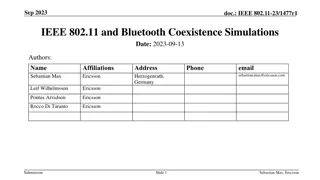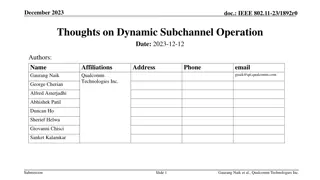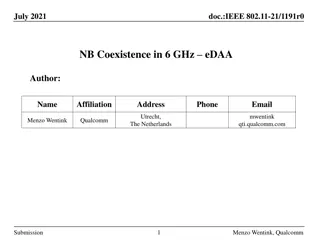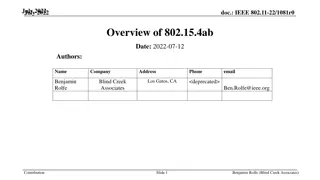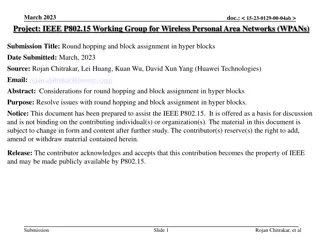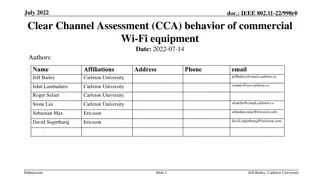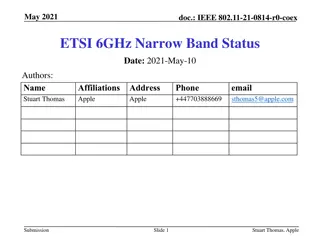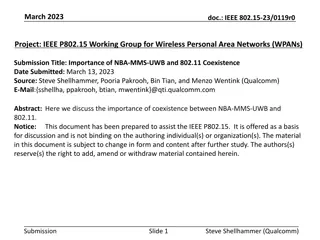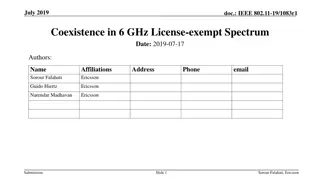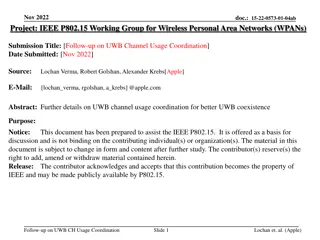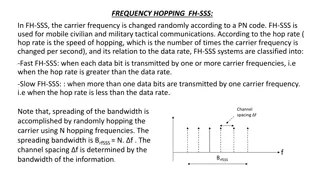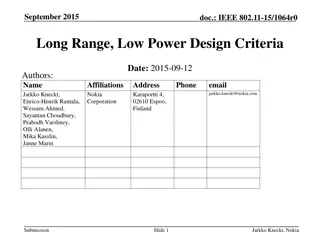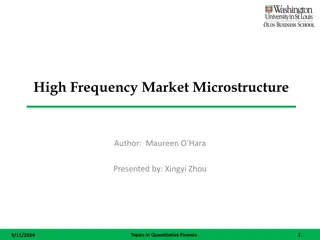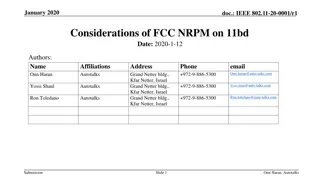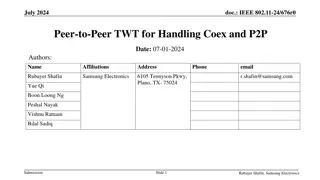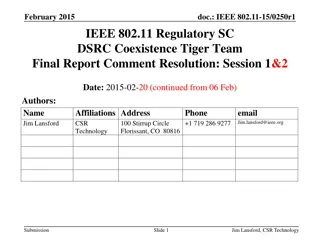Coexistence Study of Narrowband Frequency Hopping Systems and Wi-Fi
The document discusses the coexistence of Narrowband Frequency Hopping (NB FH) systems and Wi-Fi, focusing on the behavior of commercial Wi-Fi equipment when exposed to NB FH signals in the same frequency channel. It includes methodology, signal analysis in the time domain, changes made based on feedback from a previous meeting, and the test setup diagram. Valuable feedback from a meeting led to improved measurements and corrected signal generation. Various parameters and scenarios are explored to understand the impact of coexistence between these systems.
Download Presentation

Please find below an Image/Link to download the presentation.
The content on the website is provided AS IS for your information and personal use only. It may not be sold, licensed, or shared on other websites without obtaining consent from the author. Download presentation by click this link. If you encounter any issues during the download, it is possible that the publisher has removed the file from their server.
E N D
Presentation Transcript
September 2022 doc.: IEEE 802.11-22/1578r1 Coexistence of Narrowband Frequency Hopping (NB FH) systems and Wi-Fi Date: 2022-09-13 Authors: Name Jeff Bailey Affiliations Carleton University Address Phone email jeffbailey@cmail.carleton.ca ioannis@sce.carleton.ca John Lambadaris Carleton University rogerselzer@cmail.carleton.ca Roger Selzer Carleton University stoneliu@cmail.carleton.ca sebastian.max@ericsson.com david.sugirtharaj@ericsson.com Stone Liu Carleton University Sebastian Max Ericsson David Sugirtharaj Ericsson Submission Slide 1 Jeff Bailey et al, Carleton University
September 2022 doc.: IEEE 802.11-22/1578r1 Recap Document 11-22/998r0, Clear Channel Assessment (CCA) behavior of commercial Wi-Fi equipment Presented in the July 2022 Meeting s WNG session Analyze how commercial Wi-Fi products react to NB FH signals present in the same frequency channel Methodology A 2 MHz band limited additive gaussian noise (BLAGN) signal is produced in baseband BLAGN signal transmitted into Wi-Fi channel Varying dwell times and duty cycles, emulating hopping in and out of the specified Wi-Fi channel Submission Slide 2 Jeff Bailey et al, Carleton University
September 2022 doc.: IEEE 802.11-22/1578r1 NB FH Signals in Time Domain 20 % Duty Cycle, 60 ms Dwell time NB FH Signal Dwell Time Duration that signal is active T Periodicity of the signal Duty Cycle Ratio of dwell time to period Normalized absolute magnitude Dwell Time T Time (s) Submission Slide 3 Jeff Bailey et al, Carleton University
September 2022 doc.: IEEE 802.11-22/1578r1 Changes with respect to 11-22/998r0 20 % Duty Cycle, 60 ms Dwell time NB FH Signal Very valuable feedback at IEEE 802.11 July meeting Highly appreciated, enormously helpful comments thanks to all meeting participants! Resulted in improved measurement setup Fixed issue in dwell time duration calculation Repeated all measurements with corrected signal generator Normalized absolute magnitude Dwell Time T Time (s) Submission Slide 4 Jeff Bailey et al, Carleton University
September 2022 doc.: IEEE 802.11-22/1578r1 Test Setup (Diagram) Signal strength reference point If not stated otherwise, Wi-Fi signal strength is at 6 dB above NB FH signal strength (-49, -55 dBm respectively) Submission Slide 5 Jeff Bailey et al, Carleton University
September 2022 doc.: IEEE 802.11-22/1578r1 Impact of Duty Cycle & Dwell Time Increased duty cycle results in decreased Wi-Fi throughput Increased dwell time results in increased Wi-Fi throughput Across all duty cycles, short dwell time has largest impact on Wi-Fi throughput Less impact on Wi-Fi throughput at longer dwell times for each duty cycle tested Worst case throughput less than 50 % of maximum Wi-Fi throughput Submission Slide 6 Jeff Bailey et al, Carleton University
September 2022 doc.: IEEE 802.11-22/1578r1 Impact of Frequency Offset Swept NB FH signal Centre Frequency across Wi-Fi channel 36 at 200 kHz increments The effect of NB FH signals on Wi-Fi throughput at frequency offsets less than 7.6 MHz is approximately uniform NB FH signals at frequency offsets greater than 7.6 MHz have a reduced impact on Wi-Fi throughput 5.17 GHz 5.19 GHz Wi-Fi Channel 36 (CF = 5.18 GHz, BW = 20 MHz) Submission Slide 7 Jeff Bailey et al, Carleton University
September 2022 doc.: IEEE 802.11-22/1578r1 Impact of Relative Power Three Test Cases: 1. NB FH = 50 dBm, Wi-Fi = 36 dBm 2. NB FH = 50 dBm, Wi-Fi = 44 dBm 3. NB FH = 60 dBm, Wi-Fi = 54 dBm Lower absolute power NB FH signals have less impact on Wi-Fi throughput Increasing power of Wi-Fi relative to NB FH does not significantly reduce the impact on Wi-Fi throughput. Submission Slide 8 Jeff Bailey et al, Carleton University
September 2022 doc.: IEEE 802.11-22/1578r1 Impact of NB FH Signal Bandwidth Changing Bandwidth of the NB FH signals (MHz): 2, 4, 8, 12, 16 Results Show: Similar Wi-Fi throughput for each bandwidth NB FH signal Except: 100 s dwell time Throughput decreases as bandwidth increases Submission Slide 9 Jeff Bailey et al, Carleton University
September 2022 doc.: IEEE 802.11-22/1578r1 Observing CCA Mechanism s Internal States Modified access point Capable of logging the internal state of CCA mechanism Records duration that AP deems channel to be occupied No Wi-Fi traffic (generation of beacons and all other management traffic disabled) Pure passive monitoring Compare Known transmission duration with Channel occupation duration as determined by Wi- Fi CCA mechanism Submission Slide 10 Jeff Bailey et al, Carleton University
September 2022 doc.: IEEE 802.11-22/1578r1 Results: Detection Ratio Detection Ratio Duty Cycle 20 %, Dwell Time 16 ms Bandwidth EDT Occ. 2 MHz 4 MHz 5 MHz 6 MHz 8 MHz 12 MHz 16 MHz 20 MHz 9.3 % 11.7 % 13.3 % 14.6 % 15.2 % 17.6 % 19.1 % 19.8 % 46.9 % 58.3 % 66.4 % 73.2 % 76.2 % 87.8 % 95.3 % 99.2 % The Wi-Fi device can detect higher bandwidth signals more accurately than lower bandwidth signals Submission Slide 11 Jeff Bailey et al, Carleton University
September 2022 doc.: IEEE 802.11-22/1578r1 Conclusions After the Montreal meeting and presentation: Discussion from interested individuals led to review of experiment methodology and revealed issues which required addressing The issues were addressed, fixed, and subsequent re-experimentation took place. Examined parameters impact on Wi-Fi throughput: Duty cycle shown to have clear impact Shorter dwell time demonstrated to have higher impact than longer reducing the period of the NB FH signal Frequency offset has been observed to have a uniform impact over the portion of the channel where Wi-Fi is active Bandwidth has not been observed to independently impact Wi-Fi throughput Submission Slide 12 Jeff Bailey et al, Carleton University


